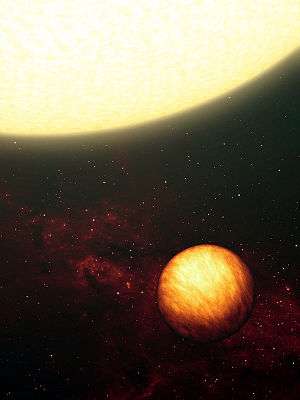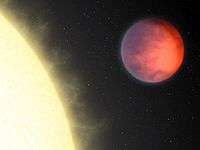Upsilon Andromedae b
| Exoplanet | List of exoplanets | |
|---|---|---|
 | ||
| Parent star | ||
| Star | Upsilon Andromedae A | |
| Constellation | Andromeda | |
| Right ascension | (α) | 01h 36m 47.8s |
| Declination | (δ) | +41° 24′ 20″ |
| Apparent magnitude | (mV) | 4.09 |
| Distance | 44.0 ± 0.1 ly (13.49 ± 0.03 pc) | |
| Spectral type | F8V[1] | |
| Mass | (m) | 1.27 (± 0.12)[2] M☉ |
| Radius | (r) | 1.480 (± 0.087)[3] R☉ |
| Temperature | (T) | 6213 (± 44)[4] K |
| Metallicity | [Fe/H] | 0.09 (± 0.06)[2] |
| Age | 3.12 (± 0.2) [5] Gyr | |
| Orbital elements | ||
| Semi-major axis | (a) | 0.0595 ± 0.0034[6] AU (~8.91 Gm) |
| ~4.41 mas | ||
| Periastron | (q) | 0.0549 ± 0.0046 AU (~8.22 Gm) |
| Apastron | (Q) | 0.0609 ± 0.0046 AU (~9.11 Gm) |
| Eccentricity | (e) | 0.022±0.007[6] |
| Orbital period | (P) | 4.62±0.23[6] d (0.01328 y) |
| (~116.4 h) | ||
| Inclination | (i) | 24±4[7]° |
| Argument of periastron |
(ω) | 44.106 ± 25.561[5]° |
| Time of periastron | (T0) | 2,450,034.053 ± 0.328[5] JD |
| Semi-amplitude | (K) | 70.51 ± 0.45[6] m/s |
| Physical characteristics | ||
| Mass | (m) | 1.70+0.33 −0.24[7] MJ |
| Discovery information | ||
| Discovery date | June 23, 1996 | |
| Discoverer(s) | Marcy et al. | |
| Discovery method | Radial velocity | |
| Other detection methods | Reflection/emission modulations | |
| Discovery site | California and Carnegie Planet Search | |
| Discovery status | Published | |
| Other designations | ||
Saffar, 50 Andromedae b, Upsilon Andromedae Ab | ||
| Database references | ||
| Extrasolar Planets Encyclopaedia | data | |
| SIMBAD | data | |
| Exoplanet Archive | data | |
| Open Exoplanet Catalogue | data | |
Upsilon Andromedae b (υ Andromedae b, abbreviated Upsilon And b, υ And b), also named Saffar, is an extrasolar planet approximately 44 light-years away from the Sun in the constellation of Andromeda. The planet orbits the solar analog star, Upsilon Andromedae A, approximately every five days. Discovered in June 1996 by Geoffrey Marcy and R. Paul Butler, it was one of the first hot Jupiters to be discovered. It is also one of the first non-resolved planets to be detected directly. Upsilon Andromedae b is the innermost known planet in its planetary system.
In July 2014 the International Astronomical Union launched a process for giving proper names to certain exoplanets and their host stars.[8] The process involved public nomination and voting for the new names.[9] In December 2015, the IAU announced the winning name was Saffar for this planet.[10] The winning name was submitted by the Vega Astronomy Club of Morocco and honours the 11th Century astronomer Ibn al-Saffar of Muslim Spain.[11]
Discovery
Like the majority of known extrasolar planets, Upsilon Andromedae b was detected by the variations in its star's radial velocity caused by the planet's gravity. The variations were detected by making sensitive measurements of the Doppler shift of Upsilon Andromedae's spectrum. The planet's existence was announced in January 1997, together with 55 Cancri b and the planet orbiting Tau Boötis.[12]
Like 51 Pegasi b, the first extrasolar planet discovered around a normal star, Upsilon Andromedae b orbits very close to its star, closer than Mercury does to our Sun. The planet takes 4.617 days to complete an orbit, with a semimajor axis of 0.0595 AU.[13]
A limitation of the radial velocity method used to detect Upsilon Andromedae b is that only a lower limit on the mass can be found. The true mass may be much greater depending on the inclination of the orbit. A mass of 1.70 MJ and an inclination of 24° were later found using high-resolution spectroscopy.[7]
Physical characteristics
Given the planet's high mass, it is likely that Upsilon Andromedae b is a gas giant with no solid surface.
The Spitzer Space Telescope measured the planet temperature, and found that the difference between the two sides of Upsilon Andromedae b of about 1,400 degrees Celsius, ranging from minus 20 to 230 degrees to about 1,400 to 1,650 degrees Celsius.[14] The temperature difference has led to speculation that Upsilon Andromedae b is tidal locked with the same side always facing Upsilon Andromedae A.
Sudarsky had, on the assumption that the planet is similar to Jupiter in composition and that its environment is close to chemical equilibrium, predicted Upsilon Andromedae b to have reflective clouds of silicates and iron in its upper atmosphere.[15] The cloud deck instead absorbs the sun's radiation; between that and the hot, high pressure gas surrounding the mantle, exists a stratosphere of cooler gas.[16] The outer shell of dark, opaque, hot cloud is assumed to consist of vanadium and titanium oxides ("pM planets"), but other compounds like tholins cannot be ruled out yet.
The chemical elements in the atmosphere can be studied by finding their absorpion lines in the thermal spectrum of the planet; given typical planet temperatures, the spectrum has its peak at infrared wavelengths. So far, only water vapor has been detected in this planet, while carbon monoxide and methane are still under the detection limit. [7]
The planet is unlikely to have large moons, since tidal forces would either eject them from orbit or destroy them on short timescales compared to the age of the system.[17]
The planet (with 51 Pegasi b) was deemed a candidate for direct imaging by Planetpol.[18] Preliminary results from polarimetric studies indicate that the planet has predominately blue color, is 1.36 times as large and 0.74 times as massive as Jupiter, meaning that the mean density is 0.36g/cm3. It has a geometric albedo of 0.35 in visible light.[19] Tidal heating models predict a similar mass for the planet. [20]
Effect on the parent star

Upsilon Andromedae b appears to be responsible for increased chromospheric activity on its parent star. Observations suggest that there is a "hot spot" on the star around 169° away from the sub-planetary point. This may be the result of interactions between the magnetic fields of the planet and the star. The mechanism may be similar to that responsible for the activity of RS Canum Venaticorum variable stars, or the interaction between Jupiter and its moon Io.[21]
See also
References
- ↑ "ups And". SIMBAD. Centre de données astronomiques de Strasbourg. Retrieved 2009-05-20.
- 1 2 Fuhrmann, Klaus; Pfeiffer, Michael J.; Bernkopf, Jan (August 1998), "F- and G-type stars with planetary companions: upsilon Andromedae, rho (1) Cancri, tau Bootis, 16 Cygni and rho Coronae Borealis", Astronomy and Astrophysics, 336: 942–952, Bibcode:1998A&A...336..942F.
- ↑ van Belle, Gerard T.; von Braun, Kaspar (2009). "Directly Determined Linear Radii and Effective Temperatures of Exoplanet Host Stars". The Astrophysical Journal. 694 (2): 1085–1098. arXiv:0901.1206. Bibcode:2009ApJ...694.1085V. doi:10.1088/0004-637X/694/2/1085.
- ↑ "Exoplanets Data Explorer". exoplanet.org. Retrieved 4 September 2016.
- 1 2 3 McArthur, Barbara E.; et al. (2010). "New Observational Constraints on the υ Andromedae System with Data from the Hubble Space Telescope and Hobby Eberly Telescope" (PDF). The Astrophysical Journal. 715 (2): 1203. Bibcode:2010ApJ...715.1203M. doi:10.1088/0004-637X/715/2/1203.
- 1 2 3 4 Ligi, R.; et al. (2012). "A new interferometric study of four exoplanet host stars : θ Cygni, 14 Andromedae, υ Andromedae and 42 Draconis". Astronomy & Astrophysics. 545: A5. arXiv:1208.3895. Bibcode:2012A&A...545A...5L. doi:10.1051/0004-6361/201219467.
- 1 2 3 4 Pizkorz, D.; et al. (August 2017). "Detection of Water Vapor in the Thermal Spectrum of the Non-transiting Hot Jupiter Upsilon Andromedae b". The Astronomical Journal. 154 (2): 78. Bibcode:2017AJ....154...78P. doi:10.3847/1538-3881/aa7dd8.
- ↑ NameExoWorlds: An IAU Worldwide Contest to Name Exoplanets and their Host Stars. IAU.org. 9 July 2014
- ↑ NameExoWorlds The Process
- ↑ Final Results of NameExoWorlds Public Vote Released, International Astronomical Union, 15 December 2015.
- ↑ NameExoWorlds The Approved Names
- ↑ Butler, R. Paul; et al. (1997). "Three New 51 Pegasi-Type Planets". The Astrophysical Journal. 474 (2): L115–L118. Bibcode:1997ApJ...474L.115B. doi:10.1086/310444.
- ↑ Butler, R. P.; et al. (2006). "Catalog of Nearby Exoplanets". The Astrophysical Journal. 646 (1): 505–522. arXiv:astro-ph/0607493. Bibcode:2006ApJ...646..505B. doi:10.1086/504701. (web version)
- ↑ Harrington, J; Hansen BM; Luszcz SH; Seager S; Deming D; Menou K; Cho JY; Richardson LJ (October 27, 2006). "The phase-dependent infrared brightness of the extrasolar planet upsilon Andromedae b". Science. 314 (5799): 623–6. arXiv:astro-ph/0610491. Bibcode:2006Sci...314..623H. doi:10.1126/science.1133904. PMID 17038587.
- ↑ Sudarsky, David; et al. (2003). "Theoretical Spectra and Atmospheres of Extrasolar Giant Planets". The Astrophysical Journal. 588 (2): 1121–1148. arXiv:astro-ph/0210216. Bibcode:2003ApJ...588.1121S. doi:10.1086/374331.
- ↑ Ivan Hubeny; Adam Burrows (2008). "Spectrum and atmosphere models of irradiated transiting extrasolar giant planets". Proceedings of the International Astronomical Union. 4: 239. arXiv:0807.3588v1. Bibcode:2009IAUS..253..239H. doi:10.1017/S1743921308026458.
- ↑ Barnes, J.; O'Brien, D. (2002). "Stability of Satellites around Close-in Extrasolar Giant Planets". The Astrophysical Journal. 575 (2): 1087–1093. arXiv:astro-ph/0205035. Bibcode:2002ApJ...575.1087B. doi:10.1086/341477.
- ↑ Lucas, P. W.; Hough, J. H.; Bailey, J. A.; Tamura, M.; Hirst, E.; Harrison, D. (11 February 2009). "Planetpol polarimetry of the exoplanet systems 55 Cnc and τ Boo". Monthly Notices of the Royal Astronomical Society. 393 (1): 229–244. arXiv:0807.2568. Bibcode:2009MNRAS.393..229L. doi:10.1111/j.1365-2966.2008.14182.x.
- ↑ S.V. Berdyugina; A.V. Berdyugin; V. Piirola (14 September 2011). "Upsilon Andromedae b in polarized light: New constraints on the planet size, density and albedo". arXiv:1109.3116 [astro-ph.EP].
- ↑ Deitrick, R.; et al. (January 2015). "The Three-dimensional Architecture of the υ Andromedae Planetary System". The Astrophysical Journal. 798 (1). Bibcode:2015ApJ...798...46D. doi:10.1088/0004-637X/798/1/46.
- ↑ Shkolnik, E.; et al. (2005). "Hot Jupiters and Hot Spots: The Short- and Long-term Chromospheric Activity on Stars with Giant Planets". The Astrophysical Journal. 622 (2): 1075–1090. arXiv:astro-ph/0411655. Bibcode:2005ApJ...622.1075S. doi:10.1086/428037.
External links
- "A Triple-Planet System Orbiting Ups Andromedae". San Francisco State University. Lick Observatory. Retrieved 2008-06-23.
- "Mystery Solved: How The Orbits Of Extrasolar Planets Became So Eccentric". SpaceDaily. 2005-04-14. Retrieved 2008-06-23.
- "NASA's Spitzer Sees Day and Night on Exotic World". NASA. Spitzer Space Telescope. 2006-10-12. Archived from the original on October 22, 2007. Retrieved 2008-06-23.
- "Upsilon Andromedae". The Internet Encyclopedia of Science. Retrieved 2008-06-23.
- "Upsilon Andromedae". The Planet Project. Archived from the original on 2008-05-18. Retrieved 2008-06-23.
- "Upsilon Andromedae 2". SolStation. Retrieved 2008-06-23.
- "The Upsilon Andromedae Planetary System". Harvard-Smithsonian Center for Astrophysics. Retrieved 2008-06-23.